SEO
A Complete Guide For Beginners

Designed to facilitate professional connections, LinkedIn Ads can be one of the best platforms in your marketing arsenal – if you know how to use it.
Why should you advertise on LinkedIn? The platform boasts 850+ million members, with 40% of visitors engaging with a page every week. Check out this article for more data from LinkedIn, including paid engagement stats.
Ready to get learn how to advertise on LinkedIn? Let’s go.
LinkedIn Advertising Options: An Overview
LinkedIn used to be extremely limited with its advertising options, which didn’t give marketers many options for achieving their goals.
But that has changed. LinkedIn appears committed to providing advertisers with the freedom they need to create ads based on their specific objectives, namely one of the following:
- Brand awareness.
- Website visits.
- Engagement.
- Video views.
- Lead generation.
- Website conversions.
- Job applicants.
The most commonly used objectives with LinkedIn advertising are lead generation, job applications, video views, and website visits, but you can successfully use the platform for any of these.
Why Advertise On LinkedIn?
Billing itself as “the world’s largest professional network,” LinkedIn has more than 875 million members in more than 200 countries and territories.
And, as the only social platform focused solely on business-to-business connections, it’s the ideal place for B2B marketing.
No matter what industry you’re targeting, you’re going to find the majority of the major players on LinkedIn.
Even more importantly, LinkedIn is a platform where you’re most likely to find the actual decision-makers you’re looking for. Need to identify the C-suite executives of a manufacturing firm? LinkedIn is the place to look.
Trying to go after mortgage brokers at small- to mid-sized firms? LinkedIn lets you do that.
Hiring for a new sales role and want only candidates with 5+ years of experience? You guessed it, LinkedIn is the place to search.
According to the platform’s own research, 80% of LinkedIn members influence their organization’s buying decisions, they have twice the buying power of an average web audience, and they are a whopping SIX times more likely to convert.
So again, if you’re not using them already, you need to get on the LinkedIn Ads train right away.
How Do LinkedIn Ads Work?
Using LinkedIn Ads is a fairly easy process, particularly if you have experience in pay-per-click (PPC) advertising already.
To get started, sign up for LinkedIn Business Manager. This gives you a single place from which you can manage all your ad accounts and pages.
In this step, you can invite team members and partners, set permissions, and add assets.
From there, you just need to choose an objective (awareness, consideration, or conversions), choose your targeting options (location, attributes, etc.), pick your ad’s format, and set your budget.
Types Of LinkedIn Ads
Based on the objective you choose, you’ll be given four different ad types you can use:
Sponsored Content
Think of this as a promoted post. You’re promoting an article or post from your company page that appears in the LinkedIn feed.
These ads do have the highest CPC on average, so proceed with caution and make sure the content you’re promoting is well thought out.
Text Ads
These are the tiny little ads you may or may not notice on the right side rail of a LinkedIn feed. Think Facebook Ads circa 2010.
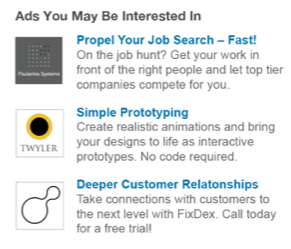 Screenshot from LinkedIn, January 2023
Screenshot from LinkedIn, January 2023Aside from the right column, these ads may appear underneath the “People You May Know” section. This is where text content can really make or break your ad conversions.
Test a few different strategies but really get to the point with these ads.
Sponsored InMail
This is a super fun way to spam someone’s LinkedIn inbox. But, when done properly, it can actually convert higher than any of the other LinkedIn ad options.
Because these ads need to come from a personal profile versus a branded business page, people feel less like they are being sold and more as they can actually communicate with a representative of the business.
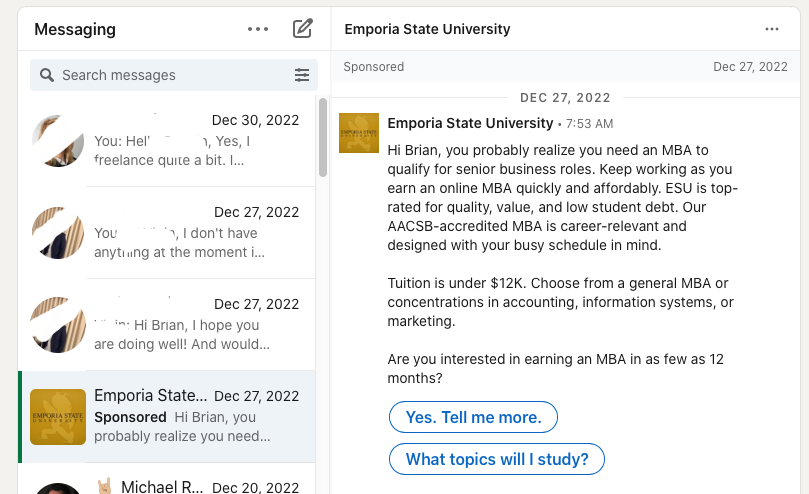 Screenshot from LinkedIn, January 2023
Screenshot from LinkedIn, January 2023Just please don’t copy and paste templates to any of your demographics. Make sure and make each InMail personal.
Video Ads
A bit self-explanatory here, but LinkedIn’s video ads help promote your videos to your ideal target market. You should be creating a ton of video content.
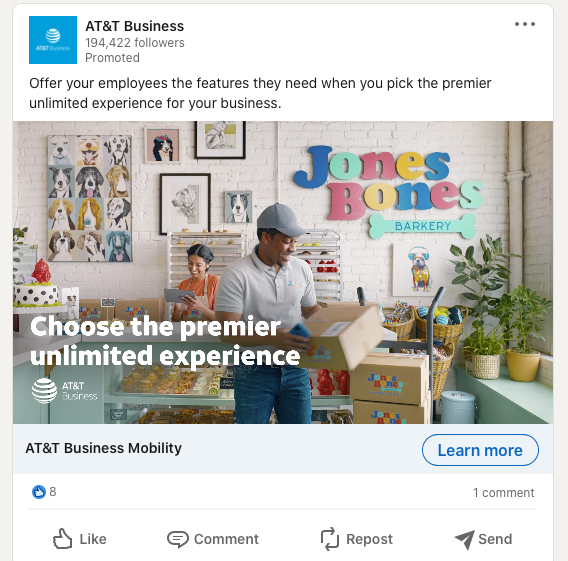 Screenshot from LinkedIn, January 2023
Screenshot from LinkedIn, January 2023Test various videos to see which type of video (topic, length, real life/animation) gives you the most conversions.
Need help with the ad dimensions and specs? Here’s all of the info you’ll need for each ad type and objective as you begin creating ads for LinkedIn:
How To Track LinkedIn Ad Conversions
Site-Wide Insight Tag
This tag gives you the 411 on what actions are happening on your website, thanks to your LinkedIn ad.
Like the Facebook pixel, you can install this tag once and watch the data come in.
It won’t mess up the speed of your site either, but it will allow you to track what’s happening on your website as a result of your LinkedIn ad.
BONUS: You can also set up LinkedIn retargeting ads once you have the Insight tag installed and a steady amount of site visitors.
Event-Specific Pixel
This type of tracking pixel is created more for the lead-gen type of objective.
Say you have a form you want someone to fill out from your LinkedIn ad, but you don’t have a thank you page set up or connected.
You can install this code and still have a “conversion event” tracked each time the form is completed.
You can also add conversion tracking to existing campaigns – so fear not those who haven’t set up conversion tracking.
LinkedIn Ads Best Practices
Now that you know how you can use LinkedIn Ads, let’s dive into the nuts and bolts of how you should be using LinkedIn and discuss some best practices to help you get the best results.
Pinpoint Your Target Audience
To help you identify and go after the targets who are most likely to act, you need to ask some questions like:
- Who is your demographic, more than just male/female, age/location?
- Have they worked in the same industry their whole lives?
- Are they generally lower management or upper management?
- Do they hold onto their job for two to four years for each position?
- Do they follow Richard Branson on LinkedIn?
You should already know the answers to all these questions, and if, for some terrible reason, you don’t, find out the answers.
LinkedIn gives B2B marketers amazing targeting options, but it can only help your ads convert if you truly know the professional side of your demographic.
Knowing how they take their coffee is great for Facebook, but on LinkedIn today, you need to know what they studied in college, if they even went to college, and select those relevant factors as targeting options.
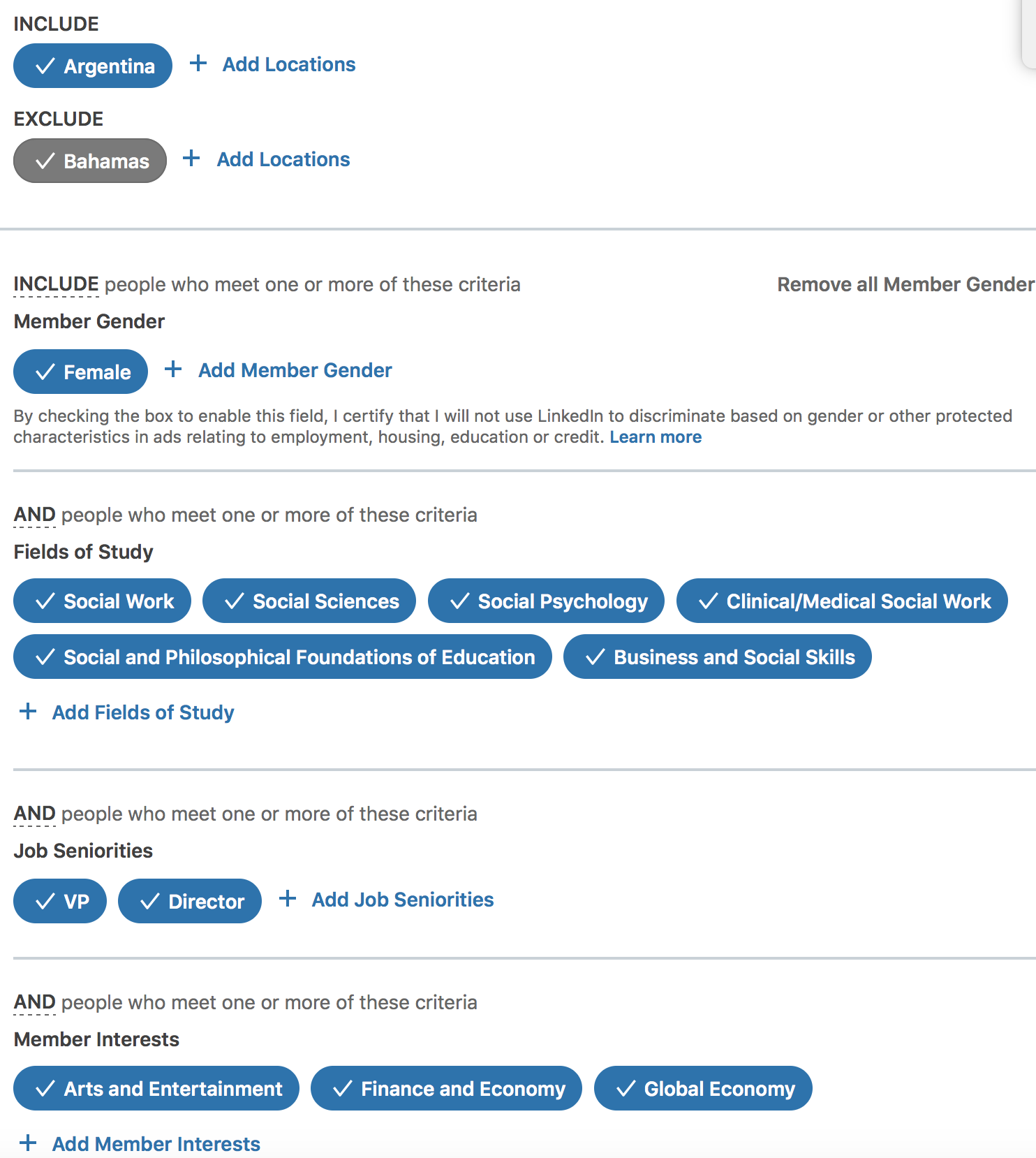
Note: You can attract a whole lot more than just CEOs with advertising on LinkedIn. Many businesses assume LinkedIn ad targeting is only great for targeting the big player, but it isn’t.
Those looking for jobs or in lower-level positions with less experience, even those who just graduated from high school or college, are perfect targeting options for LinkedIn ads.
Use LinkedIn’s Content Suggestions
LinkedIn offers Content Suggestions for business pages to help guide them on what they should write about.
Think outside of the box on this one and use trending topic ideas for ad headlines and descriptions.
The Content Suggestions are super easy to use, and you can even target those directors and CEOs you’ve been eyeballing.
Simply choose the industry, location, and seniority you’re targeting, and LinkedIn will generate the latest trending topics for those designated filters.
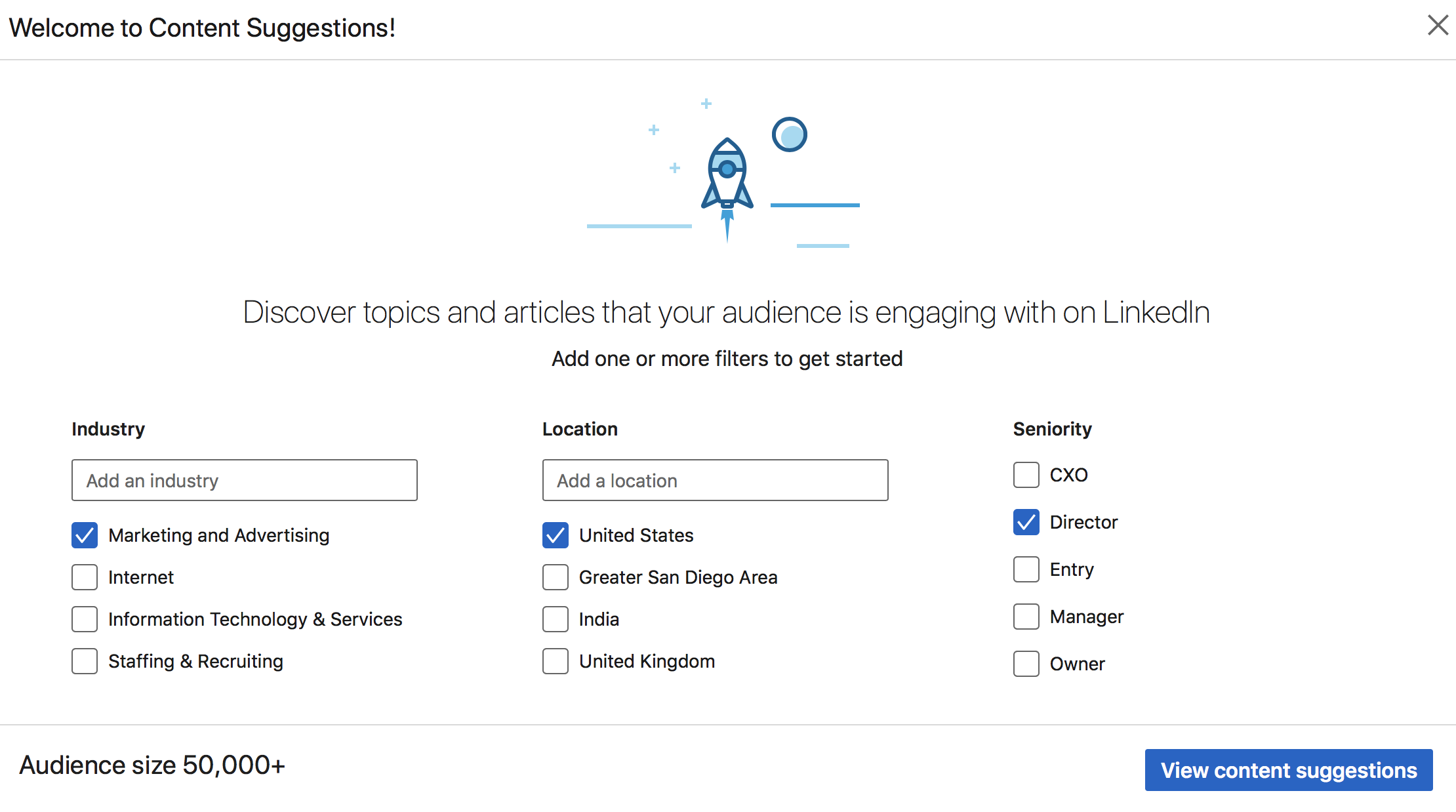
Results in:
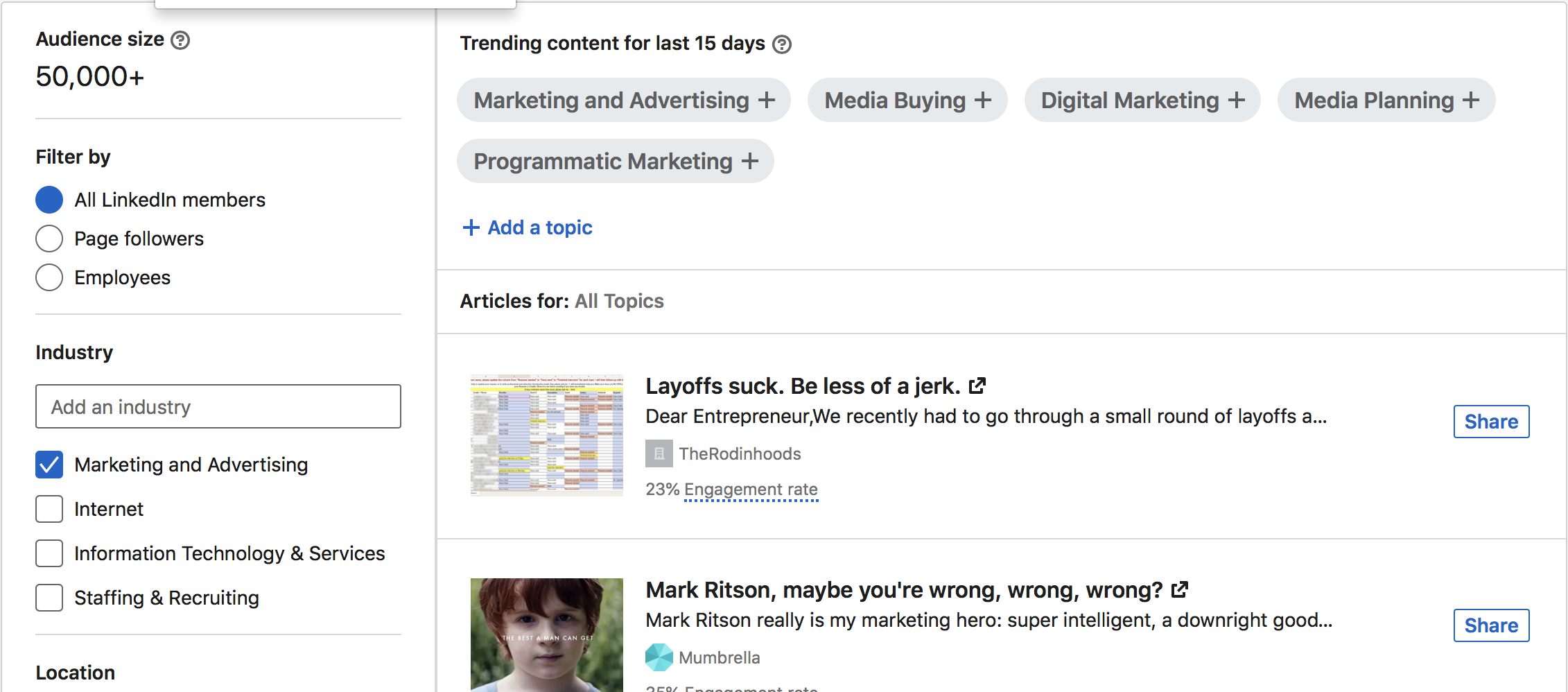
If we even take just the first article that populated in this test search, “Layoffs suck. Be less of a jerk,” we can easily snag a few different ad headline ideas:
- Sick of dealing with layoffs? So Were We Until We Tried This.
- Done Being the Jerk? Over Laying People Off? Click Here.
- What We Found From Layoffs – Click Here
If an article is trending, it’s because people have liked it and engaged with it.
Don’t you want those same people to like and engage with your ad, too? Of course, you do.
Create Lead Gen Forms
One of the best reasons to use LinkedIn Ads is that it allows you to generate high-quality leads with proven return on investment (ROI).
And the best way to do that is by using the platform’s built-in Lead Gen Forms.
Available for both message ads and sponsored content, they’re easy to set up and can be directed to just by adding a call to action (CTA) to your ad. Once a user clicks on the ad, they’ll see a pre-filled form that already includes their name and relevant info.
Submitting the form, LinkedIn members can be directed to specific “Thank You!” pages that connect to your website, ebook download site, or any other destination.
And because marketers love numbers, Lead Gen Forms make it really simple to measure the impact of campaigns.
Via either your Campaign Manager or the third-party platform of your choice, you can generate reports on important metrics like cost per lead, form fill rate, and audience information.
If You’re In B2B, You Should Be Using LinkedIn Ads
For professional or business-to-business marketing, there really is nothing quite like LinkedIn.
By offering the flexibility you want in social media advertising, combined with a good ROI, it can help you reach decision-makers like never before.
But, like most things marketing-related, you can’t expect miracles to happen overnight. It will likely take some experimentation and fine-tuning before you settle on the best approach for your organization’s needs.
Just have some patience and a clear strategy, and you’ll have this powerful social platform reaping the rewards for you before you know it.
Featured Image: ZacoDot/Shutterstock
SEO
Google Further Postpones Third-Party Cookie Deprecation In Chrome

Google has again delayed its plan to phase out third-party cookies in the Chrome web browser. The latest postponement comes after ongoing challenges in reconciling feedback from industry stakeholders and regulators.
The announcement was made in Google and the UK’s Competition and Markets Authority (CMA) joint quarterly report on the Privacy Sandbox initiative, scheduled for release on April 26.
Chrome’s Third-Party Cookie Phaseout Pushed To 2025
Google states it “will not complete third-party cookie deprecation during the second half of Q4” this year as planned.
Instead, the tech giant aims to begin deprecating third-party cookies in Chrome “starting early next year,” assuming an agreement can be reached with the CMA and the UK’s Information Commissioner’s Office (ICO).
The statement reads:
“We recognize that there are ongoing challenges related to reconciling divergent feedback from the industry, regulators and developers, and will continue to engage closely with the entire ecosystem. It’s also critical that the CMA has sufficient time to review all evidence, including results from industry tests, which the CMA has asked market participants to provide by the end of June.”
Continued Engagement With Regulators
Google reiterated its commitment to “engaging closely with the CMA and ICO” throughout the process and hopes to conclude discussions this year.
This marks the third delay to Google’s plan to deprecate third-party cookies, initially aiming for a Q3 2023 phaseout before pushing it back to late 2024.
The postponements reflect the challenges in transitioning away from cross-site user tracking while balancing privacy and advertiser interests.
Transition Period & Impact
In January, Chrome began restricting third-party cookie access for 1% of users globally. This percentage was expected to gradually increase until 100% of users were covered by Q3 2024.
However, the latest delay gives websites and services more time to migrate away from third-party cookie dependencies through Google’s limited “deprecation trials” program.
The trials offer temporary cookie access extensions until December 27, 2024, for non-advertising use cases that can demonstrate direct user impact and functional breakage.
While easing the transition, the trials have strict eligibility rules. Advertising-related services are ineligible, and origins matching known ad-related domains are rejected.
Google states the program aims to address functional issues rather than relieve general data collection inconveniences.
Publisher & Advertiser Implications
The repeated delays highlight the potential disruption for digital publishers and advertisers relying on third-party cookie tracking.
Industry groups have raised concerns that restricting cross-site tracking could push websites toward more opaque privacy-invasive practices.
However, privacy advocates view the phaseout as crucial in preventing covert user profiling across the web.
With the latest postponement, all parties have more time to prepare for the eventual loss of third-party cookies and adopt Google’s proposed Privacy Sandbox APIs as replacements.
Featured Image: Novikov Aleksey/Shutterstock
SEO
How To Write ChatGPT Prompts To Get The Best Results

ChatGPT is a game changer in the field of SEO. This powerful language model can generate human-like content, making it an invaluable tool for SEO professionals.
However, the prompts you provide largely determine the quality of the output.
To unlock the full potential of ChatGPT and create content that resonates with your audience and search engines, writing effective prompts is crucial.
In this comprehensive guide, we’ll explore the art of writing prompts for ChatGPT, covering everything from basic techniques to advanced strategies for layering prompts and generating high-quality, SEO-friendly content.
Writing Prompts For ChatGPT
What Is A ChatGPT Prompt?
A ChatGPT prompt is an instruction or discussion topic a user provides for the ChatGPT AI model to respond to.
The prompt can be a question, statement, or any other stimulus to spark creativity, reflection, or engagement.
Users can use the prompt to generate ideas, share their thoughts, or start a conversation.
ChatGPT prompts are designed to be open-ended and can be customized based on the user’s preferences and interests.
How To Write Prompts For ChatGPT
Start by giving ChatGPT a writing prompt, such as, “Write a short story about a person who discovers they have a superpower.”
ChatGPT will then generate a response based on your prompt. Depending on the prompt’s complexity and the level of detail you requested, the answer may be a few sentences or several paragraphs long.
Use the ChatGPT-generated response as a starting point for your writing. You can take the ideas and concepts presented in the answer and expand upon them, adding your own unique spin to the story.
If you want to generate additional ideas, try asking ChatGPT follow-up questions related to your original prompt.
For example, you could ask, “What challenges might the person face in exploring their newfound superpower?” Or, “How might the person’s relationships with others be affected by their superpower?”
Remember that ChatGPT’s answers are generated by artificial intelligence and may not always be perfect or exactly what you want.
However, they can still be a great source of inspiration and help you start writing.
Must-Have GPTs Assistant
I recommend installing the WebBrowser Assistant created by the OpenAI Team. This tool allows you to add relevant Bing results to your ChatGPT prompts.
This assistant adds the first web results to your ChatGPT prompts for more accurate and up-to-date conversations.
It is very easy to install in only two clicks. (Click on Start Chat.)
For example, if I ask, “Who is Vincent Terrasi?,” ChatGPT has no answer.
With WebBrower Assistant, the assistant creates a new prompt with the first Bing results, and now ChatGPT knows who Vincent Terrasi is.
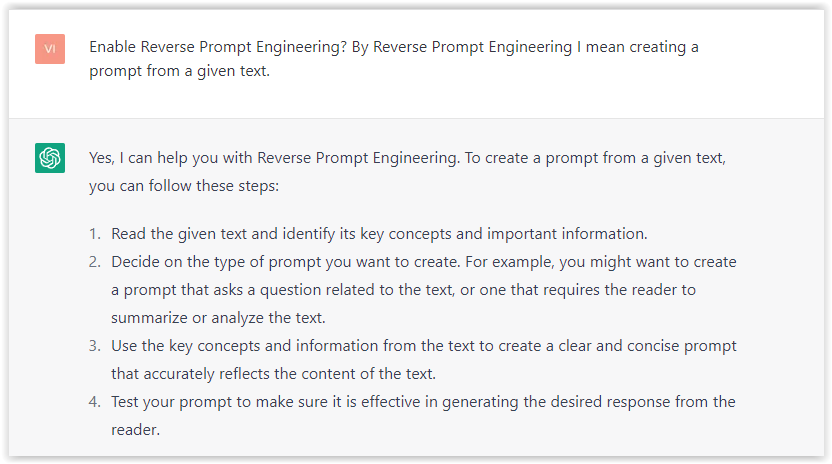 Screenshot from ChatGPT, March 2023
Screenshot from ChatGPT, March 2023You can test other GPT assistants available in the GPTs search engine if you want to use Google results.
Master Reverse Prompt Engineering
ChatGPT can be an excellent tool for reverse engineering prompts because it generates natural and engaging responses to any given input.
By analyzing the prompts generated by ChatGPT, it is possible to gain insight into the model’s underlying thought processes and decision-making strategies.
One key benefit of using ChatGPT to reverse engineer prompts is that the model is highly transparent in its decision-making.
This means that the reasoning and logic behind each response can be traced, making it easier to understand how the model arrives at its conclusions.
Once you’ve done this a few times for different types of content, you’ll gain insight into crafting more effective prompts.
Prepare Your ChatGPT For Generating Prompts
First, activate the reverse prompt engineering.
- Type the following prompt: “Enable Reverse Prompt Engineering? By Reverse Prompt Engineering I mean creating a prompt from a given text.”
 Screenshot from ChatGPT, March 2023
Screenshot from ChatGPT, March 2023ChatGPT is now ready to generate your prompt. You can test the product description in a new chatbot session and evaluate the generated prompt.
- Type: “Create a very technical reverse prompt engineering template for a product description about iPhone 11.”
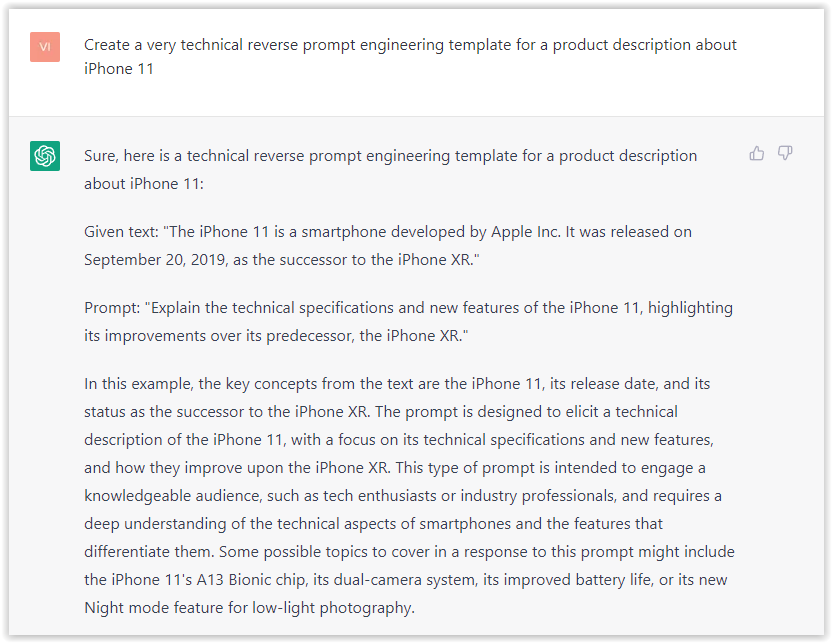 Screenshot from ChatGPT, March 2023
Screenshot from ChatGPT, March 2023The result is amazing. You can test with a full text that you want to reproduce. Here is an example of a prompt for selling a Kindle on Amazon.
- Type: “Reverse Prompt engineer the following {product), capture the writing style and the length of the text :
product =”
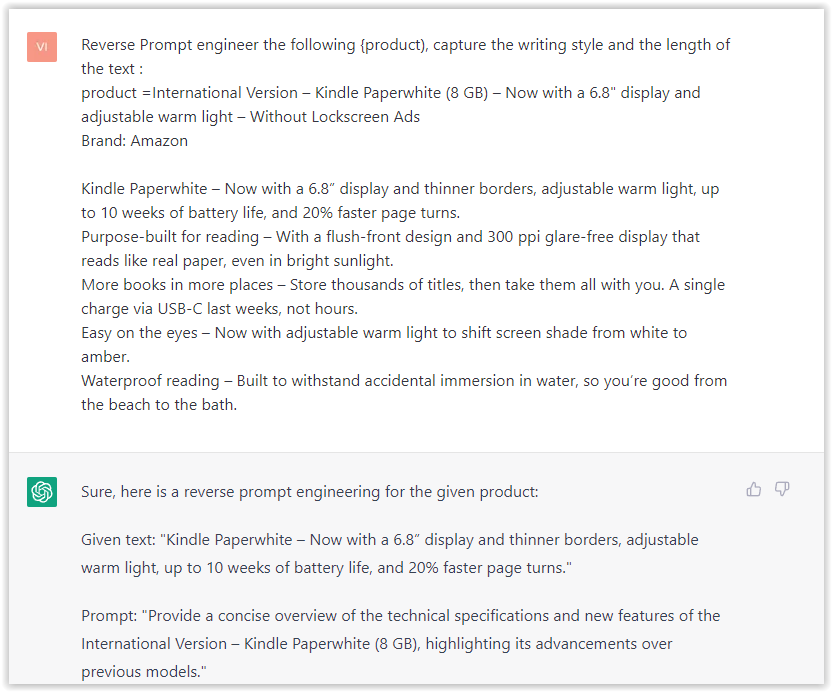 Screenshot from ChatGPT, March 2023
Screenshot from ChatGPT, March 2023I tested it on an SEJ blog post. Enjoy the analysis – it is excellent.
- Type: “Reverse Prompt engineer the following {text}, capture the tone and writing style of the {text} to include in the prompt :
text = all text coming from https://www.searchenginejournal.com/google-bard-training-data/478941/”
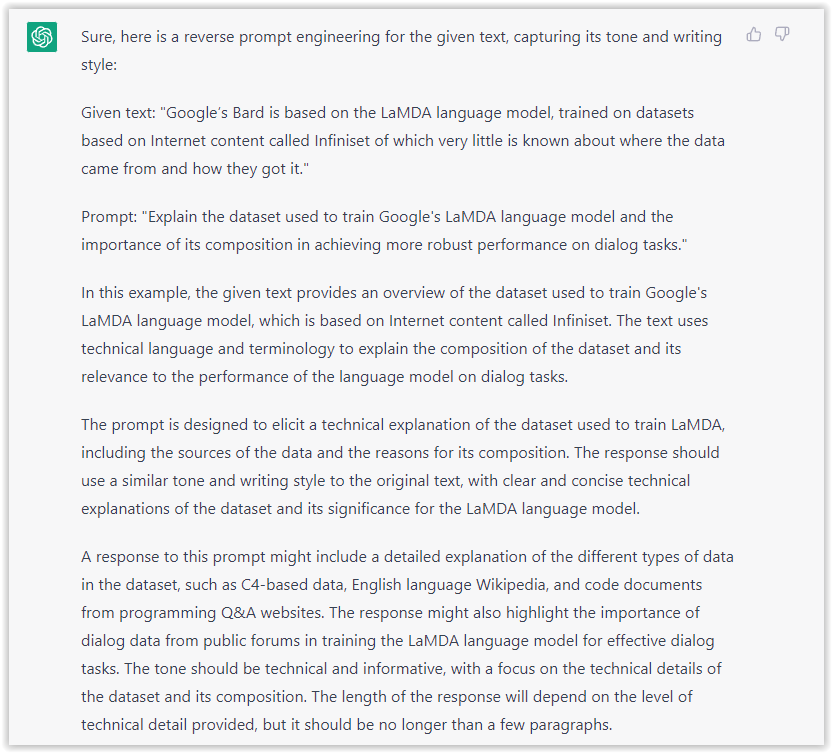 Screenshot from ChatGPT, March 2023
Screenshot from ChatGPT, March 2023But be careful not to use ChatGPT to generate your texts. It is just a personal assistant.
Go Deeper
Prompts and examples for SEO:
- Keyword research and content ideas prompt: “Provide a list of 20 long-tail keyword ideas related to ‘local SEO strategies’ along with brief content topic descriptions for each keyword.”
- Optimizing content for featured snippets prompt: “Write a 40-50 word paragraph optimized for the query ‘what is the featured snippet in Google search’ that could potentially earn the featured snippet.”
- Creating meta descriptions prompt: “Draft a compelling meta description for the following blog post title: ’10 Technical SEO Factors You Can’t Ignore in 2024′.”
Important Considerations:
- Always Fact-Check: While ChatGPT can be a helpful tool, it’s crucial to remember that it may generate inaccurate or fabricated information. Always verify any facts, statistics, or quotes generated by ChatGPT before incorporating them into your content.
- Maintain Control and Creativity: Use ChatGPT as a tool to assist your writing, not replace it. Don’t rely on it to do your thinking or create content from scratch. Your unique perspective and creativity are essential for producing high-quality, engaging content.
- Iteration is Key: Refine and revise the outputs generated by ChatGPT to ensure they align with your voice, style, and intended message.
Additional Prompts for Rewording and SEO:
– Rewrite this sentence to be more concise and impactful.
– Suggest alternative phrasing for this section to improve clarity.
– Identify opportunities to incorporate relevant internal and external links.
– Analyze the keyword density and suggest improvements for better SEO.
Remember, while ChatGPT can be a valuable tool, it’s essential to use it responsibly and maintain control over your content creation process.
Experiment And Refine Your Prompting Techniques
Writing effective prompts for ChatGPT is an essential skill for any SEO professional who wants to harness the power of AI-generated content.
Hopefully, the insights and examples shared in this article can inspire you and help guide you to crafting stronger prompts that yield high-quality content.
Remember to experiment with layering prompts, iterating on the output, and continually refining your prompting techniques.
This will help you stay ahead of the curve in the ever-changing world of SEO.
More resources:
Featured Image: Tapati Rinchumrus/Shutterstock
SEO
Measuring Content Impact Across The Customer Journey
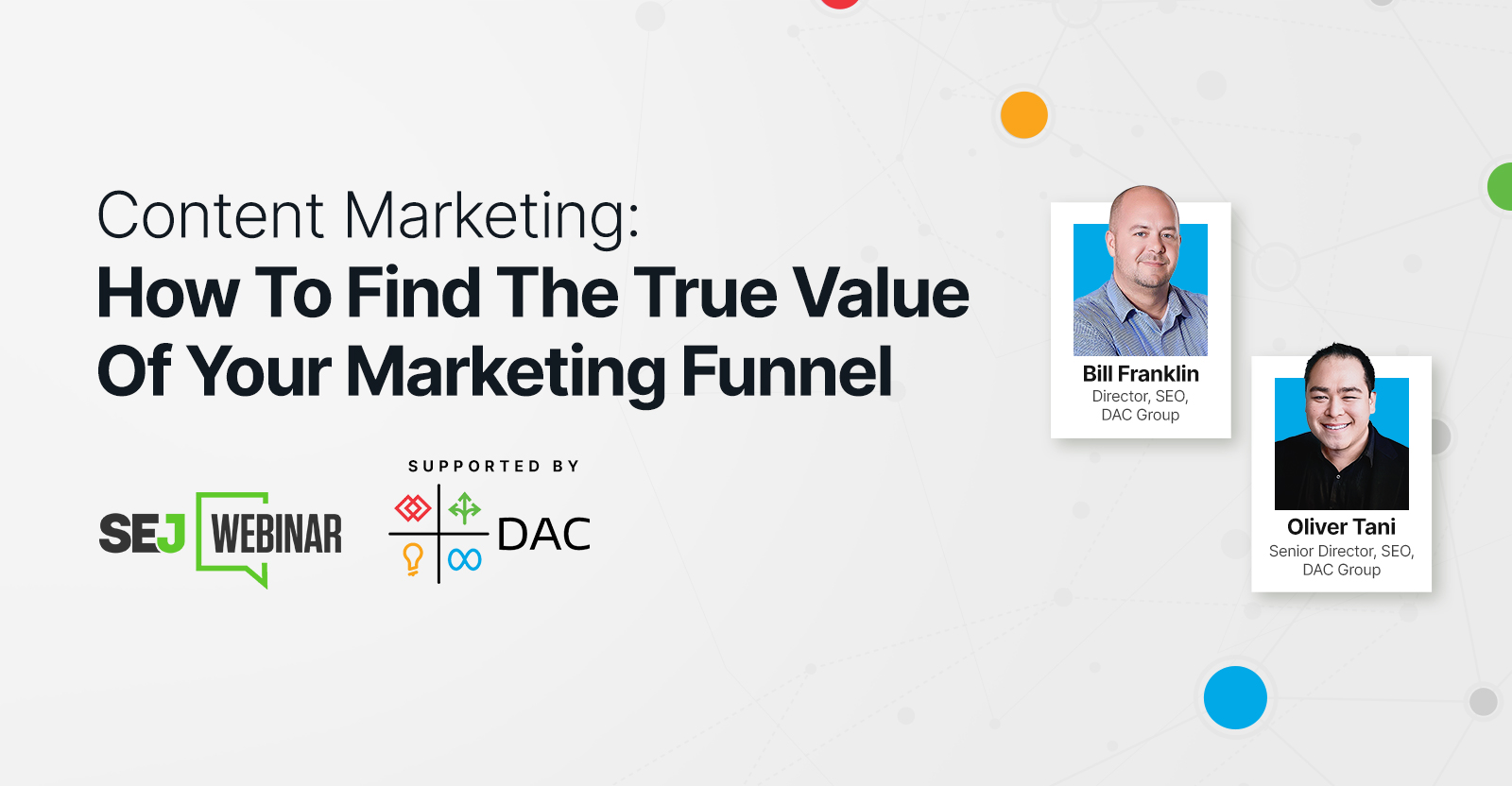
Understanding the impact of your content at every touchpoint of the customer journey is essential – but that’s easier said than done. From attracting potential leads to nurturing them into loyal customers, there are many touchpoints to look into.
So how do you identify and take advantage of these opportunities for growth?
Watch this on-demand webinar and learn a comprehensive approach for measuring the value of your content initiatives, so you can optimize resource allocation for maximum impact.
You’ll learn:
- Fresh methods for measuring your content’s impact.
- Fascinating insights using first-touch attribution, and how it differs from the usual last-touch perspective.
- Ways to persuade decision-makers to invest in more content by showcasing its value convincingly.
With Bill Franklin and Oliver Tani of DAC Group, we unravel the nuances of attribution modeling, emphasizing the significance of layering first-touch and last-touch attribution within your measurement strategy.
Check out these insights to help you craft compelling content tailored to each stage, using an approach rooted in first-hand experience to ensure your content resonates.
Whether you’re a seasoned marketer or new to content measurement, this webinar promises valuable insights and actionable tactics to elevate your SEO game and optimize your content initiatives for success.
View the slides below or check out the full webinar for all the details.
-

 PPC6 days ago
PPC6 days ago19 Best SEO Tools in 2024 (For Every Use Case)
-

 MARKETING7 days ago
MARKETING7 days agoEcommerce evolution: Blurring the lines between B2B and B2C
-
SEARCHENGINES5 days ago
Daily Search Forum Recap: April 19, 2024
-
SEARCHENGINES6 days ago
Daily Search Forum Recap: April 18, 2024
-

 WORDPRESS6 days ago
WORDPRESS6 days agoHow to Make $5000 of Passive Income Every Month in WordPress
-

 SEO7 days ago
SEO7 days ago2024 WordPress Vulnerability Report Shows Errors Sites Keep Making
-

 WORDPRESS6 days ago
WORDPRESS6 days ago10 Amazing WordPress Design Resouces – WordPress.com News
-
WORDPRESS7 days ago
[GET] The7 Website And Ecommerce Builder For WordPress
















You must be logged in to post a comment Login